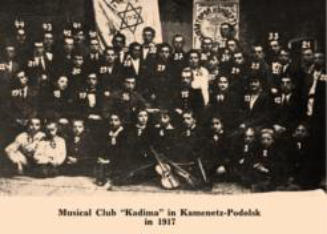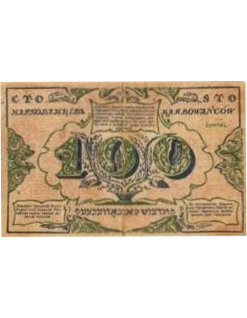
Compiled by Martin Davis © 2010- 2017
The Growth of Jewish Education and Cultural Life
In 1851, with the support of local maskilim (those committed to the Jewish Enlightenment or Haskalah), two Jewish schools were established, where, among others, Avraham Gottlober and Sholem Yankev Abramovitsh (Mendele Moykher-Sforim) served as teachers. In the 1860s a private women’s school (the Blovstein Girls School) and Talmud Torah were opened. The local non-Jewish men’s high school had 25 Jewish pupils in 1871 (6% of the total student body), while the women’s had 60 Jewish pupils in 1899 (15%). Jewish youth also studied in other public schools within the limits of a restriction on numbers of Jews allowed admission. The Kamenets Jewish community also maintained a hospital with an almshouse and a soup kitchen (see image - shelter for the poor) [1].The New Politics
In 1905 Czar Nicholas II issued a manifesto proclaiming a new constitution. Soon after this, riots and pogroms erupted which were organised by the secret anti Jewish nationalist movement of the Black Hundreds. In Kamenets there was a mobilization of rioters among peasants from outlying villages. Although the riot in Kamenets resulted in broken window panes and general disruption there were no casualties [2]. At this time, the Jewish socialist parties, which had been operating secretly, came out into the open and started spreading written and oral propaganda in the city. The ‘party propagandists cornered workers’ on their way home from work and also held political meetings to propagate their ideals - active parties included the Social Democrats, Socialist Revolutionaries, Anarchists and the Poale Zion. Each of the parties had its own meeting place in one of the four streets of the city’s central square [2]. In the last years of the First World War, the struggle between the various Jewish political and intellectual factions (Jewish Bolsheviks, Mensheviks, Social Democrats and Zionists) grew and papers, pamphlets, recruitment to groups and the publication of opposing local Jewish newspapers became very much part of daily life in Kamenets. However, some of the age old antagonisms continued and authorities in Kamenets succeeded in quashing pogroms in 1914, but during the Civil War (1919–1920), approximately 100 Jews were killed in pogroms in the area.The Kamenets Jewish Community and Symon Petlyura’s Directorate
unenlightened masses to various excesses against Jews. The Commander-in-Chief invited the representatives of the Jewish people to a closer cooperation of both peoples for the good of the Ukrainian State, for, only with united forces would it be possible to look after the interests of both peoples, which had always been identical.Communist Suppression of Jewish Life
By the end of 1920, the Soviet government had taken over Kamenets but Jewish life in the city continued. From 1923, with support from the Jewish Public Committee to Aid Victims of the War and Pogroms and other charitable organisations, three Jewish schools were established and according to Ben-Zion Fendler ...”All synagogues were open until 1936, many of them bustling with multitudes of worshippers [3] However, the Jewish population was decreasing as families and individuals either went to other parts of the country. By 1926 only 12,774 Jews remained (in the 1920s it is known that 76 families left to settle in Crimea, and 80 to settle in Birobidzhan) [1]. Ben-Zion Fendler further wrote that the Kamenets Yevsektsiya (the Jewish anti-religious organisation within the Bolshevik Party) tolerated the Jewish community’s activities and did not persecute or terrorise the religious Jews - as was the case elsewhere. Apparently the head of the Yevsektsiya for the city , although an ardent communist, showed benevolence toward the religious community. However, in 1936 there was a clamp-down and all the synagogues with the exception of the Gedalia Heller synagogue were closed and all religious items (apart from 30 Torah scrolls which were hidden by synagogue officials) were confiscated and are today part of the Collection of Judaica in the Museum of Historical Treasures of the Ukraine in Kiev. From this time on religious Jews went to the Gedaliah “...It was impossible to crowd into the synagogue. The courtyard was full and many people stood in the neighbouring streets with the hope that they could hear the service” [3]. Additionally, all Jewish schools were closed, as was the House of Jewish Culture, with its drama studio.After World War Two
A small number of Jews who returned to Kamenets after the war tried to organize a community in 1946–1947. However, the authorities turned down their application to restore the Tailor’s Synagogue, they were also banned from gathering for prayers in private premises, and they were refused legalisation of a community organization. The Jews did manage to erect monuments at the mass murder sites. In 1959 there were 2,400 Jews in the town (6% of the total population), a number that dwindled to 1,800 by 1979. In 1992, the Shalom Jewish Cultural Club was organized with more than 1,000 members. A Sunday school began operating in 1994 with about 30 pupils. From 1995 to 1999, a monthly regional Jewish newspaper, Shalom Aleikhem, appeared. The Jewish Agency opened an office in the town and in 1999 the American Jewish Joint Distribution Committee organized a local branch, which performed social services for about 500 Jews and their families and became the central Jewish cultural and educational institution of Kamenets [1].
[1] Kamianets-Podilskyi . An article Benyamin Lukin
[2] Kaminits-Podolsk and its Environs Randolph. Ed Abraham Rosen and others. Published by the Avotaynu Foundation Inc
Bergenfield NJ 1999. p.p.16
[3] Kaminits-Podolsk and its Environs Randolph. Ed Abraham Rosen and others. Published by the Avotaynu Foundation Inc
Bergenfield NJ 1999. p.p.45
Podolski Kray (1920) - one of the two
Kamenets Jewish newspapers


Students and teachers of the Blovstein
Jewish Girls School c 1902
During the First World War the city was occupied by Austria-Hungary. In 1917, with the collapse
of Imperial Russia, the city was briefly incorporated into several short-lived Ukrainian states: the
Ukrainian People's Republic, the Hetmanate, and the Directorate (Directoriya) government. After
1918, during the civil war, the Jews in Kamenets-Podolski suffered severely and in July 1919,
200 Jews were killed in pogroms carried out by uncontrolled elements within Symon Petlyura's
army. From June to November 1919, Kamenets served as the capital of the Ukrainian People’s
Republic after the Russian Communist forces occupied Kiev.
On 17 July a formal Jewish delegation from the town were received by the commander-in-chief
Petlyura. The delegation included Dr. Meyer Kleiderman, the representative of the Kamenets
Jewish community; a representative of the Zionist organization; a representative of the rabbis of
the town; a representative of artisans; and a representative of the Poale Zion Party.
After expressing support for the ruling directorate, they called on president Petlyura, to take firm
measures against pogroms. He in turn addressed the delegation with a short speech in which he
declared that he himself as well as the government were always standing on the side of the
Jewish people, and were waging war against those elements who incited the
The Jewish community grew as Kamenets grew in its importance as a regional
centre. The 1897 census of the Podolian Governate showed that the Jewish adult
population numbered 16,211 (40% of the total for the city). By 1910 it had grown to
22,279 Jews (approximately 47% of the population). Four private schools and
‘modernized’ hadarim (Jewish elementary schools) were operating, and later also
two Hebrew schools and a library.
In the mid-1880s, a Hoveve Zion movement was formed, and by the end of the
nineteenth century Kamenets had become the centre of the Zionist movement in
the region, hosting the first regional conference in 1902. The head of the movement
in Kamenets was David Schleifer, a local lawyer, his influence across the whole
Jewish community of Kamenets was considerable and as well as being the main
spokesman for the Zionist movement he was spokesman on behalf of the broader
Jewish community during this period.


100 Karbonvanets banknote of the Ukraine
Republic (circa 1917) denomination in
Russian, Ukrainian and Yiddish


















